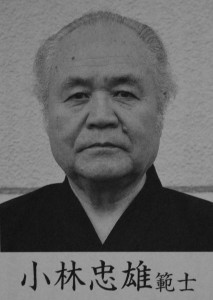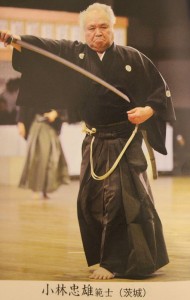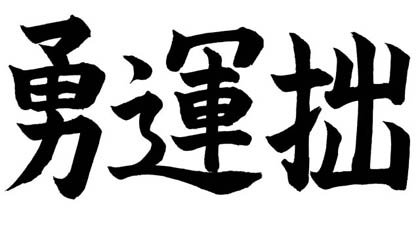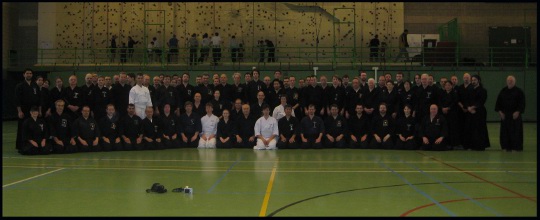ABKF Winter Seminar 2011
 This year the ABKF Winter seminar took place at the ADEPS in Auderghem between the 14th and 18th december. For some years now the Iaido teachers present in december are Kobayashi Tadao sensei – 8th dan Iaido Hanshi and Uehara Koichi – 7th dan Iaido Kyoshi. For those not familiar with Kobayashi sensei’s background, he is a former All Japan champion and an actual shinsain/judge for 8th dan examination held every year in Kyoto.
This year the ABKF Winter seminar took place at the ADEPS in Auderghem between the 14th and 18th december. For some years now the Iaido teachers present in december are Kobayashi Tadao sensei – 8th dan Iaido Hanshi and Uehara Koichi – 7th dan Iaido Kyoshi. For those not familiar with Kobayashi sensei’s background, he is a former All Japan champion and an actual shinsain/judge for 8th dan examination held every year in Kyoto.
Kobayashi sensei obtained his 8th Dan in 1988 and is a well renowned sensei with a lot of experience but I still feel the need to point out that he has a very very impressive kirioshi. Impressive not because it is fast or strong but impressive because you can really feel the cutting action. Using his entire body and sword in such a way that it gives the thrilling feeling the monouchi is physically slicing through matter as if the air was solid.
During the seminar participants were splitted into groups. Group A with the sandan and up leaded by Kobayashi sensei and group B with the nidan and less leaded by Uehara sensei. 6 keiko of 1 hour and a half were on the planning. With a group A averaging 30 participants Kobayashi sensei took time during the first keiko to explain the nukitsuke, the chiburi with the kirite and tomete difference, the link between metsuke and riai. During the following keiko he did not really went over all the ZKR Iai book points as it is often the case during big seminars but instead he carefully focused on fundamentals. This focus on fundamentals closely overlaping his writings in the “Iaido shinsain no me” book.
Kobayashi sensei’s primary concern was for us to: execute a correct furikaburi, to use our left hand with the more power, to understand shoulders usage during kiritsuke and the Ki-Ken-Tai no itchi foot mechanic. He also developed concepts such as Kan(緩)-Kyu(急)-Kyo(強)-Jaku(弱) and Kurai (位/Level/Rank). I will now try to summarize some of his remarks.
General remarks
————————————
– Sitting correctly
Many people are sitting with the shoulders and upper body completely vertical or leaning backward, the navel pointing upward. This position is incorrect and as the sensei stated this is a relax position to have a cup of tea, Obaastyle – Grandma style as our shishō Oda sensei would comment. The samurai way of sitting should be with the navel pointing horizontal or downward to the ground and the shoulder/upper body slightly leaning forward, ready to take any forward action needed. A good indicator of a wrong position is to check that in sitting position the tsuka is horizontal and not pointing excessively upward.
– Left hand usage in the nukitsuke
The sensei insisted that the left hand was really the base/foundation to perform a correct nukitsuke. If there is no power in the left hand involved during the nukitsuke it will not work. He gave a score to both hands giving a 6 (60%) to the left hand and 4 (40%) to the right. He then asked us to only focus on the left hand and forget about the right hand, the right hand power depending on the left. He then showed us a simple example demonstrating the importance of the left hand as a base/support to the right.
– Furikaburi action
Furikaburi should be a soft action and should be performed without putting excessive power with the hands or shoulders. Shoulders have to stay “low”/relaxed. Second point was that at the end of the furikaburi one must grip the tsuka correctly, not by gripping it on the side but properly aligned.
– Kiritsuke mechanics
Kobayashi sensei explained that the Kiritsuke action started with the shoulders action. Of course during this the kissaki is also moving but the arms extension and the tenouchi action should start a bit later when the katana is about to enter the opponent body and the hands are at the eyes level.
– Foot/cut speed bond
The sensei showed us the link between the foot speed and the speed of the cut and this for all actions involving moving right or left foot while performing a cut. He took mae and morotezuki nukitsuke as examples and asked us to perform a quicker and sharper move with the foot movement while cutting.
– Chiburi
During the chiburi the repartition of power between the left and right hand following the 60/40 percent rule should be observed. Pointing out the fact that the left hand should be powerful to have a balance in the action. He also came back on an explanation about the tomete grip (like holding an umbrella) used in the chiburi and the kirite used in cutting motion. Tomete being performed by gripping all the fingers at once compared to the kirite being obtained by tenouchi, finger by finger gripping.
– Kan/Kyu/Kyo/Jaku
Litteraly Kan (緩) slow – Kyuu (急) quick – Kyou(強) strong – Jyaku (弱) weak/soft refers to the strength and speed used in the different phases of the kata, always linking it to what is happening in the riai. Some actions have to be done softly and slowly and others quickly and strongly giving the kata a rythm also called meri-hari. The sensei cited a japanese metaphor explaining that “There is only a peak to a mountain because there is a valley. Only because there is a valley you can see how high the mountain is” seems quite logic but explains quite simply that a kata should not be all the way fast or slow but should vary to highlight: katsujinken, control the enemy with kiseme, decicive actions, check where/what the ennemy is/does, zanshin …
Some specific kata remarks
————————————
– Ukenagashi
One should perform the uke having the kissaki low and closing the distance to the enemy.
– Tsuka-ate
As ate is performed to suigetsu the ennemy is not direclty moving back, you need to push him away keeping your metsuke on him during the drawing of the sword. Feeling the enemy being and surpising him one should switch to the rear enemy quickly following by the tsuki. After the tsuki first look at the opponent and then cut.
– Morotezuki
Furikaburi action should be performed softly relacing fingers and hands going up directly keeping the blade aligned with the center line of the kata.
– Soogiri
Soogiri is not men kirikaeshi and should not be performed too fast but focusing on a proper kime on each cuts.
Of course there were many other points and explanations given during the seminar and I can not list them all here. This post is only an attempt to roughly summarize Kobayashi sensei’s words without having visual support for it. Nothing will ever replace live explanation and practice.
 I would like to highlight one last point of Kobayashi sensei, maybe one of the most important which is that from a certain level we have to use our brain and think about the actions present in a kata and their reasons. His concern was that our practice looked like we were just repeating the kata in an “Automatic” mode. Within the same idea he clearly stated that training a lot was very important to understand the physics of Iaido, the mechanical principles, meaning how to use his body to achieve proper moves, cuts doing suburi/kihon series being one of the top exercises to reach this goal. In the meantime it was also clear for him that practising a lot with a wrong understanding of the technique or not searching tirelessly to improve technique was completely useless.
I would like to highlight one last point of Kobayashi sensei, maybe one of the most important which is that from a certain level we have to use our brain and think about the actions present in a kata and their reasons. His concern was that our practice looked like we were just repeating the kata in an “Automatic” mode. Within the same idea he clearly stated that training a lot was very important to understand the physics of Iaido, the mechanical principles, meaning how to use his body to achieve proper moves, cuts doing suburi/kihon series being one of the top exercises to reach this goal. In the meantime it was also clear for him that practising a lot with a wrong understanding of the technique or not searching tirelessly to improve technique was completely useless.
To finish this post I would like to rewind on something Kawaguchi sensei – 8th dan Iaido Hanshi was mentioning during the last Andorra EIC: the Iaido level of someone can be represented as a pyramid, the base of the pyramid being the fundamentals and the height of the pyramid being your overall skill. The wider the base the higher the pyramid will be able to go. Meaning that to progress/go higher we need to practice and master fundamentals and continue perfecting them tirelessly.
Thanks to the received teachings and Yuki’s precious translation I am confident my pyramid skills base and the one of all participants broaden and I am sure we will all do our best to reach another level. Gambarimasho !!!
M&Y
Posted: December 22nd, 2011 under Article, Iaido.
Tags: ABKF, iaido, jaku, kan, kawaguchi, kobayashi, kurai, Kyo, Kyu, Seminar report




